The Ultimate Player's Guide to Kendama String
The string of a Kendama plays a big role in a Kendama-players life. Use this guide to find out all you need to know about Kendama string!
The string seems initially unimportant when you see Kendama for the first time... But right from the moment you do your first pull-up spike, string is KEY 🔑
Frankly, when you get more into Kendama, knowing EVERYTHING about Kendama string can be quite helpful! That's why I created this guide!
Kendama has been evolving rapidly over the last 10 years. A lot has changed, including the strings! However the manufacturers still put rigid string on their Kendamas! That's why many players choose to replace the default string.
What is Kendama string made of?
The material Kendama string is made from is Nylon. The type of string that is used for Kendama is actually 'Chinese knotting cord '. Nylon string can offer the best properties for Kendama play, but but there are a lot of different types of Nylon cord and not all are suitable for Kendama.
Continue reading to find out more, including which ones are the best.
In this guide you will get to know everything related to Kendama string, including:
- How to string a Kendama (it's easier than you think!)
- Differences between Kendama string (and which is the best Kendama string)
- Kendama Bead vs Kendama Bearing (which is really better?)
- Knots in your Kendama string (why and how to get them out)
- How long should a Kendama string be (hint: you'll use your fingers)
How to String a Kendama
Let's start with explaining how to string your Kendama, as chances are you're here to find out!
Replacing a Kendama string can seem a bit tricky at first, but figuring out how to fix a Kendama string will become easier and easier every time you do it. Just take some time to watch the video, follow along and make sure to enjoy the fun process of changing the string!
With this video you learnt how to change and tie a Kendama string. Your Kendama should be ready to play again! But that's not all there is to say about the Kendama string, we're just getting started!
What Kendama Knots should you use?
When you string your Kendama you use different knots to tie off the Ken and the Tama.
When tying off the Ken, the Sword (spike) most likely has an erea where the string can fall back into when you put the cups back on. Your knot should be big enough so that it cannot slip back through the stringing hole, but small enough so that the cups fit back over it. That's why you want to use two overhand knots on top of eachother for the Ken.
For the Kendama Knot to use when tying off the tama, when using a small bearing, just a slipped overhand knot is enough. If you are using a bigger bearing, you will want to make the knot bulkier to make sure it doesn't slip through. In that case you can add another overhand knot on top of the slipped overhand knot.
Differences between Kendama String (and which one is the best?)
In the Kendama scene, there are 3 types of string that are most commonly used.
Good Kendama string has the following properties:
- The string is flexible.
This doesn't mean the string is elastic, but that it's easily bended. This means the string will behave properly while the Ken and the Tama are flying around and there will be less tangling. - The string has the right amount of flexibility.
You want your string to have a little bit of flexibility. This makes it nicer to use when starting your tricks, where always one object hangs down while you hold the other. Too much flexibility and it will become a hindrance. It can also break a lot more easily when the string is too elastic.
This brings us to why standard Kendama string is not so good. The problem here lies often with the lack of flexibility. This makes playing Kendama less satisfying and gets the string tangled more often during play. Below we show you what better alternatives exist.
Thin string
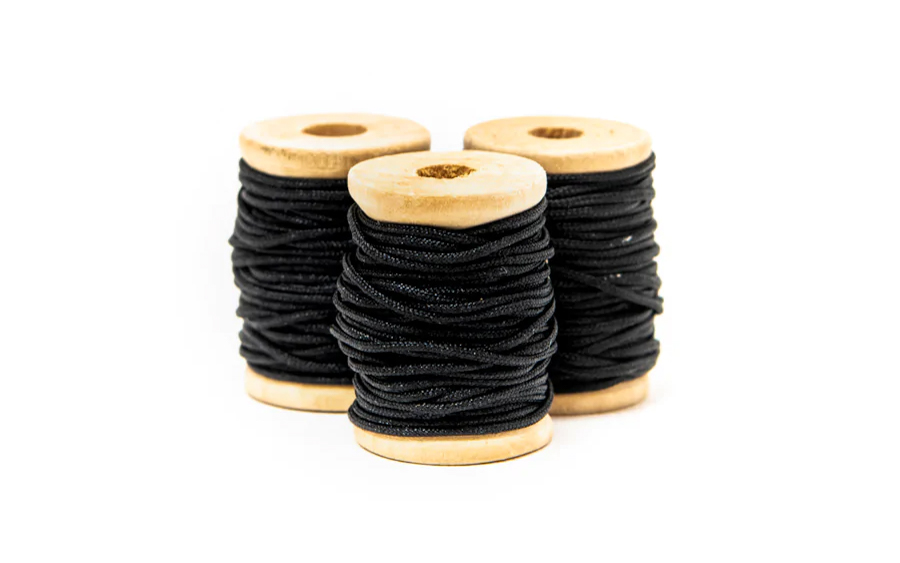
Pro: Tangles the least
Con: Feels sharp during string tricks
The term for this rope in Kendama is "Speed string". It's 0.8mm to 1mm thick, the most flexible and slightly elastic. It's the most widely used type of string and this is the string the majority of the professional Kendama players use.
Thick string
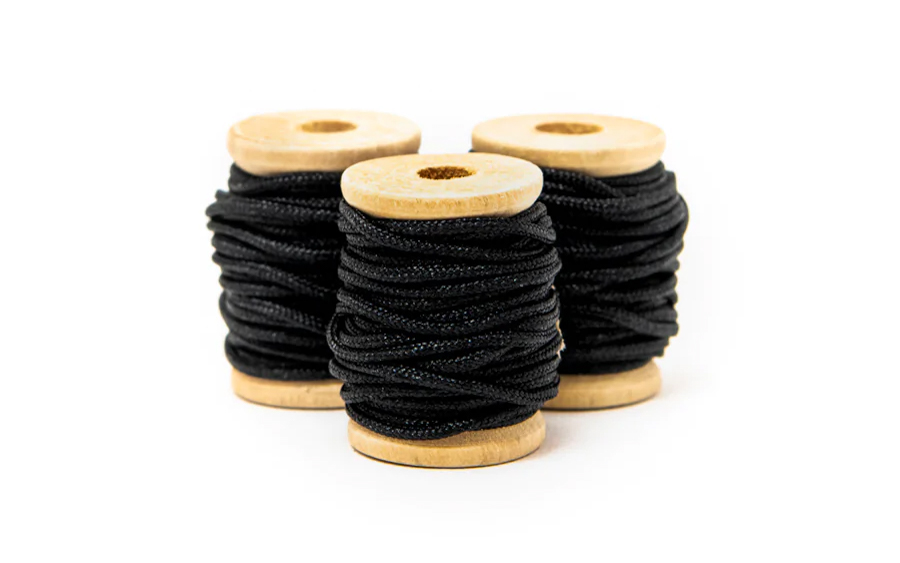
Pro: Best control during string tricks
Con: Tangles quicker than thin string
This Kendama string does not have an officially recognized name. We call it the "Steez string". We named it after an innovative Dutch player called Joey Eillebrecht started using this string for his style of play; he used the term steez often.
This String offers more control when doing tricks with the string.
Soft string
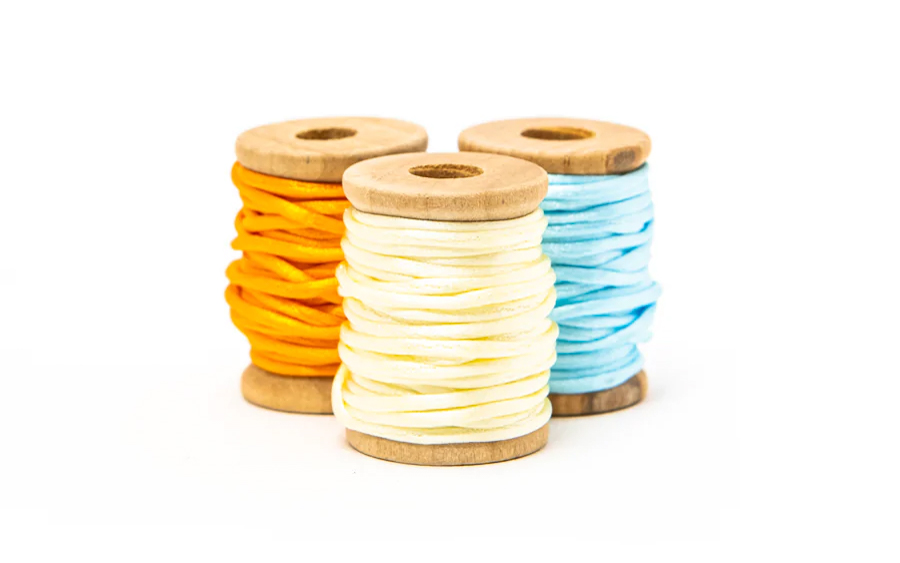
Pro: Has the softest feeling
Con: Tangles quicker than thin string
The term for this rope in Kendama is "Silk string". This string is more old-school. It was used very often before the Speed String (thin) became the golden standard. A small percentage of the players prefers the silk string to this date.
Would you like to try any of the three types of Kendama string we mentioned? Just add a note to your order to request a sample when you order a Kendama on our website. Mention in the note which types of string and which colors you would like to try!
What is the best Kendama string?
The Steez string, as we call it, turns out to give the most control for string type tricks (also known as spacewalks). The thickness and the weight of the string give it preferable properties that increase the control. Some players that are fond of doing these types of tricks choose to use this string for this reason.
However, a part of the players that like to do these tricks, still choose to use Speed string. The reason being that the speed string tangles less, and this outweighs all benefits that the steez string provides for them.
Combine this with the fact that most professional players use the Speed string, we can confidently say that speed string is the best string for general Kendama play.
Kendama Beads vs Kendama Bearings
Beads. They are so 2017...
Yet some Kendamas still come with them!! 😲
Let me explain why bearings are a must have on your Kendama string by comparing the two.
Plastic beads 🤢🤮
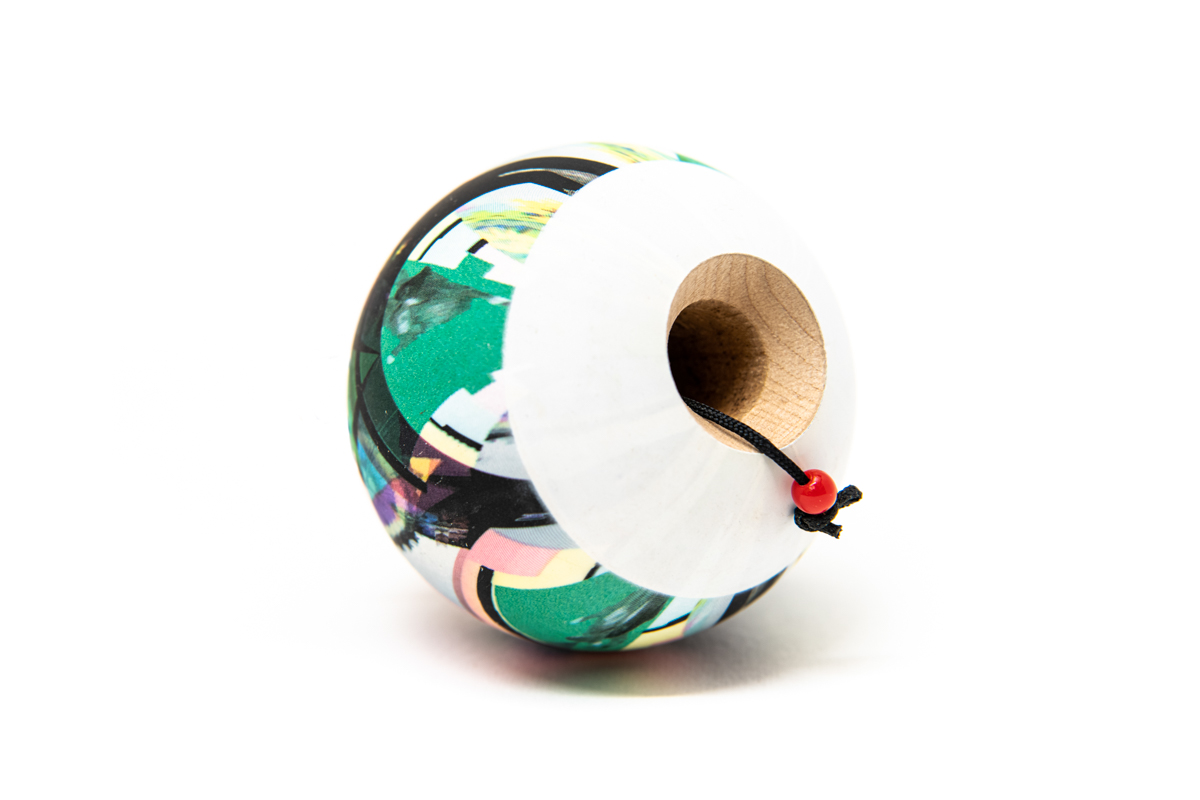
Pro: Cheap
Con: Causes the string to tangle
The best comparison here is that of a yoyo: remember when you tried to play yoyo and the string tangled time and time again..? And you ended up being frustrated and quit playing..?
Well, that's quite similar with Kendama. And we would like to prevent that from happening!
Metal ball bearing 🤑

Pro: Prevents the string from tangling
Con: Little bit more costly
When you play with your Kendama, the ball will spin in the air. With the plastic bead, the spinning of the ball causes the string to spin along until it eventually tangles up. When using the bearing, the string doesn't spin along when the ball turns, thus preventing the rope from tangling.
Pro tip:
Does the string still spin along when using the bearing? Then it's likely that the knot in the Tama is too big. This will make the string be stuck in the ball, thus it cannot unspin. If you redo the knot and make it smaller, it is likely to fix the problem.
Knots in your Kendama string.. and how do you get them out?
One thing you cannot avoid while playing Kendama is occasional knots in your string.
Most new players their response to a knot..? Just let it be. They end up with a pretty good collection of them in no-time. Believe it or not, but a string full of knots ends up demoralising the player. I'm not kidding! And then what? Do you let them sit, will you get all of them out or replace your string? What's the best to do in this situation?
My advice? Get a knot out immediately after you notice it came into existence. Here's how you do it:
- Take tension of the rope (by lifting both objects)
- If the knot is tight, chew on it a little (trust me, it helps)
- Start peeling carefully to take it out
Pro tip: Relax and take your time
If you are trying to learn a trick and you find out you have a knot in your string, see it as a good opportunity to take a break and catch your breath. Relax and enjoy the process
How long is a Kendama string?
On modern Kendamas, a Kendama string is typically 55cm to 65cm long out of the box. (This is about 22 to 26 inches.) On older Kendamas this can be much shorter!
How long should a Kendama string be?
Kendama string length depends on the type of player you are. I'll first give some context and then proceed with the detailed answer.
Over the years the length of Kendama string has increased immensely! Did you know that back in 2015, it was really not done to play anything longer than 3 fingers?
"3 fingers"..? What does that even mean?
Allow me to explain how we measure string length in Kendama!

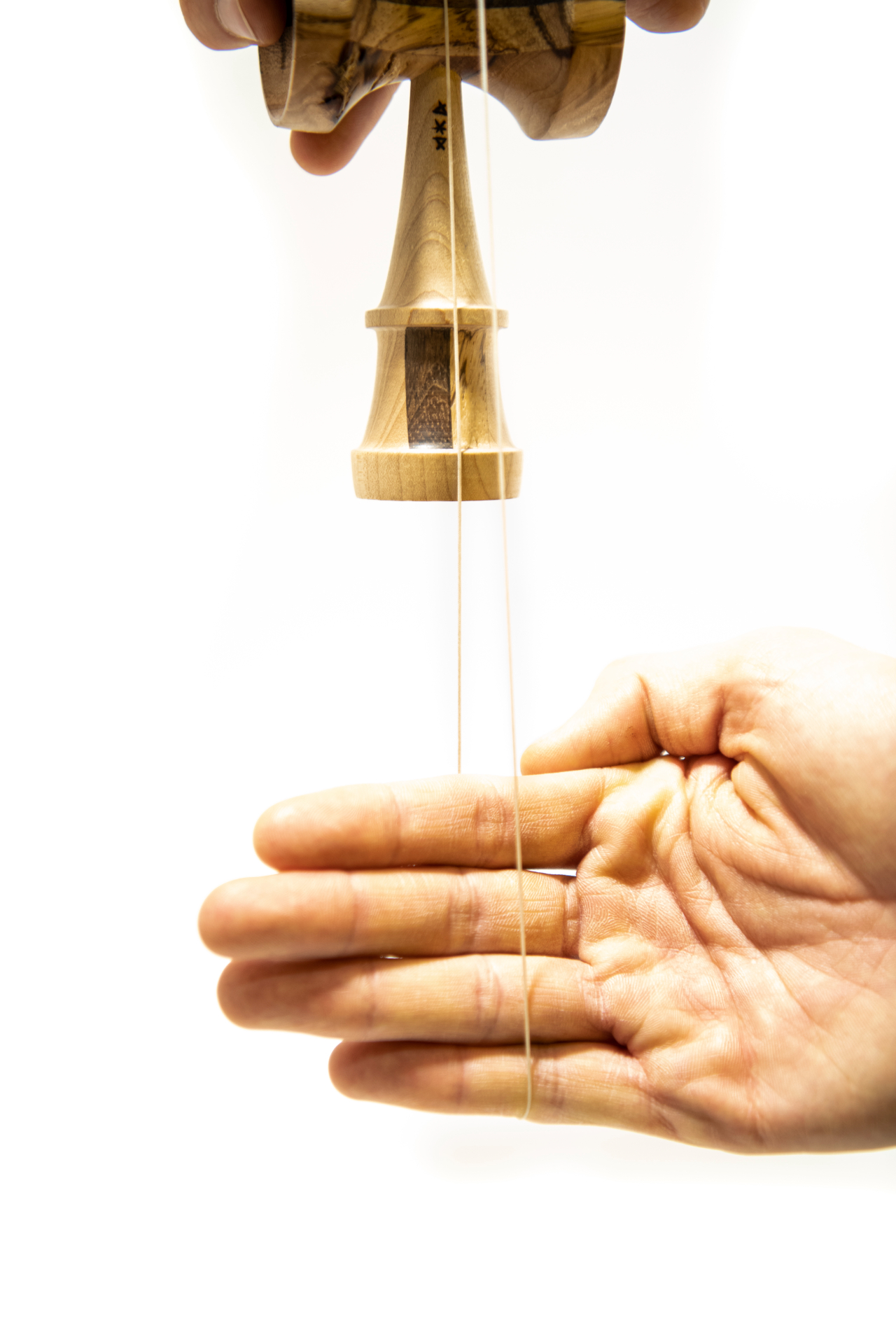
How do you measure string length?
The length of your string is measured by putting the tama on the spike with the string hanging down. You put your fingers between the string and see how many fit between the base cup.
This used to be a super good method, as strings were about 2-3 fingers long. However nowadays 8-12 fingers is not at all uncommon.
So what is the right string lenghth for me?
For kids under 8 years old who try Kendama, the string should be 2-4 fingers long.
If you are a beginner, it's advised to play 4-6 finger strings.
If you are learning juggle type-tricks, you should consider making your string as long as necessary in order to make it easier to learn. The string should never be a barrier to learning new tricks.
From this point, you should experiment what works for you, probably between 5 and 12 fingers. There's a few things to consider:
- Does your string tangle too often during juggles? Try increasing the length
- Did your pull-ups become very difficult? Then try decreasing the length.
- Are you doing tricks with the string itself? The shorter the string, the faster the tricks will go and can prevent them from looking clumsy. Consider this if style is important to you.
To conclude:
Now you know how you should choose your length. Experiment with different lengths to find what works for you.
Pro tip: Quickest way to find your length
Put on a new string (from a roll of string you have, or after asking us to give some extra string with your order). Then make cut a string that's obviously too long. Restring your Kendama, play it, make it a bit shorter with an easy knot, and try it again. Is it too short? Undo the knot. Repeat this process to find what you like best. Then cut your string, measure the length and remember it. You will now know your desired length.
Playing Kendama without a string
"Oooh, but it has a string..!" (That makes it so much easier)
Me: 🤦🏽♂️
Have you ever heard anyone who's not familiar with Kendama say this?
As if playing Kendama with a string makes it easier!? As a player you know this is the most ridiculous assumption. In fact, playing Kendama without a string is much easier!
Why? You might ask
To be fair, the string is nice to prevent you from having to pick up your Kendama 1000 times in a day. It helps the durability too. But the string tangles your Kendama! Besides learning to control your Kendama you need to learn to control your string, too! Having no string means you can play without the worry of tangling.
That makes playing without a string a very legitimate way to practise new tricks! It can be super fun! For example you can throw the objects as high as you want to without being limited by the string. Try it yourself!
Kendama strings for sale
Most players have the realization at some point that Kendama is something that will stick to them. It clicks. For those people, these are the people that restring their Kendama with their preferred string.
If you don't yet know which Kendama string is right for you, you should definitely experiment by trying out the different strings. When you know which one you want, you get your own roll of string . No silly string packs, but your own full roll of string, which will last you ages!
We have the best Kendama strings for sale! With the speed string, you can string up over 15 Kendama's. The other strings are thicker, so with the roll of steez string, you can take about 8 long strings off. The silk string holds over 10 long Kendama st
Kendama strings for sale
If you are in Europe, you should definitely consider adding some new string when purchasing a Kendama from our shop. However if you're only looking to buy string or you are located outside of Europe, I would search for "Lovely Knots - Chinese Knotting Cord 1mm" to get some of the best string in the Kendama game, with possibly less shipping cost than our website can offer you.
-
Speed String 1mm
Regular price €4,99Regular priceUnit price per
-
Steez String 1.4mm
Regular price €4,99Regular priceUnit price per Sold Out
Sold Out -
Silk String
Regular price €4,99Regular priceUnit price per Sold Out
Sold Out
Now you know everything there is about Kendama string
Please comment on this post if it was valuable to you. If you have any questions or you find any info to be missing, please also leave a comment. I would highly appreciate it!
Your feedback would also allow me to keep this post up to date and make it better over time to make sure players can find all there is to know about Kendama string, for years to come!





Leave a comment